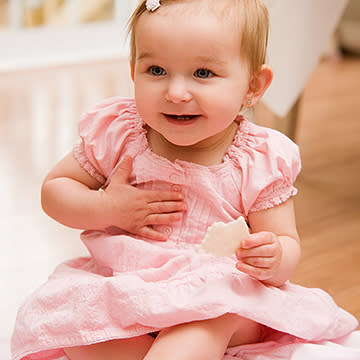No Words? No Problem. Teach Your Tot Sign Language

If you've seen Meet the Fockers then you're familiar with baby sign language. In the movie, released in 2004, Robert De Niro teaches his grandson to communicate using his hands. Though portrayed humorously in the film, baby sign language is no joke. The pop culture nod to baby signing really gave the public insight into a movement that researchers have been studying since the early 1980s: Just because babies can't talk doesn't mean they don't have anything to say.
Kids can start learning how to communicate with signs when they're as young as 6 months old. There are signs to help with food, signs that represent everyday items, outdoor-related signs, signs to help with potty training,and more.
Based on a simplified version of American Sign Language, researchers (and parents) say that baby signs are a way of alleviating frustration and even tantrums, because kids are able to express themselves.
"Signing and communicating with babies helps them communicate before they can talk," says Jamie Stevens, an independent certified instructor for the Baby Signs Program. "The muscles in the mouth are not full developed until 2 years old and so through coordination of their movements they're able to produce the simple signs and communicate with their parents and childcare givers anywhere from 6, 7, 8 months old."
Stevens shared a few of the most basic, early signs that she shares with her students:
More-Holding your hands in front of you, bring fingertips together and tap them several times.
Milk-Make a fist and squeeze, as though milking a cow.
Eat-Hold the fingers and thumbs together as though holding a small piece of food and tap to mouth.
All done-Aim palms toward floor, crossing hands over top of each other, back and forth, in front of you.
Hurt-Tap together two index fingers together, near where the pain is.
Drink-Position hand as though you're holding an imaginary cup and raise to mouth.
Sleep-Tilt your head to the side and rest your hand to your cheek, while closing your eyes.
Stevens says that once kids get the hang of it, they'll be asking for more. "As they start picking up the signs, they're craving more information," she says. "They're wanting more signs to be able to communicate."
In fact, once they start learning kids have a tendency to make up their own signs, whether it's for airplane, banana, teddy bear or whatever is meaningful to them.
"They love inventing signs," says Stevens.
When the do create their own, it's up to the parents to become the interpreter and learn what the child is saying. Stevens suggests that the parent can either adopt the sign that the child has come up with or look up the correct sign and model that for the child. Either way, the same goal is being accomplished: Communication and understanding.
To learn more about Baby Signs and/or Jamie Stevens go to www.babysignsprogram.com/withjsinterpreting.
-By Kate Silver for Parents.com
Related Links:
12 Sign Language Words for Babies
Photo courtesy iStock.
